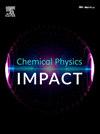CF-LIBS和CC-LIBS用于工业和环境应用的铝合金中痕量金属杂质的高灵敏度检测
IF 4.3
Q2 CHEMISTRY, PHYSICAL
引用次数: 0
摘要
本文采用无校准激光诱导击穿光谱(CF-LIBS)和常规校准激光诱导击穿光谱(CC-LIBS)对铝基体中的微量元素进行了定量分析。以铝为基材,加入铜(Cu)、锌(Zn)、锡(Sn)、硅(Si)、铅(Pb)等杂质,用532 nm、5ns脉宽的调q Nd: YAG激光器检测其独特的发射谱线。采用Al 394.4 nm谱线对Cu、Zn、Sn、Si和Pb谱线的强度进行标准化,以提高精度,减小实验误差。采用校准曲线确定各元素的检出限;Cu、Zn、Sn、Si、Al和Pb的计算值分别为3.27、4.5、2.98、4.46、0.03和3.06 ppm。此外,Al, Si和Sn的lod比先前报道的值有所增强,而Pb, Cu和Zn的lod保持不变,证实了我们研究结果的准确性。使用玻尔兹曼图技术评估等离子体变量,该技术使用铝谱线来确定等离子体温度。CF-LIBS和CC-LIBS在这项工作中显示的高灵敏度和准确性使它们成为冶金和合金检测的理想选择,这确保了汽车,航空航天和建筑行业铝基产品的纯度和成分。此外,这些方法为铝的回收和垃圾管理提供了一种快速可靠的途径,有利于金属垃圾的有效分类和净化。识别有害微量金属污染物(如Pb和Zn)的能力对环境监测具有重要意义,特别是在食品包装、医疗设备和消费电子产品中使用铝的企业。本文章由计算机程序翻译,如有差异,请以英文原文为准。

High-sensitivity detection of trace metal impurities in aluminum alloys using CF-LIBS and CC-LIBS for industrial and environmental applications
In this work, trace elements in an aluminum matrix were quantitatively analyzed using Calibration-Free Laser-Induced Breakdown Spectroscopy (CF-LIBS) and Conventional Calibration Laser-Induced Breakdown Spectroscopy (CC-LIBS). When aluminum was used as the basis metal, impurities such as Copper (Cu), Zinc (Zn), Tin (Sn), Silicon (Si), and Lead (Pb) were added, and their distinctive emission lines were examined by a Q-switched Nd: YAG laser operating at 532 nm with 5 ns pulse width. The Al 394.4 nm line was used to standardize the intensities of the Cu, Zn, Sn, Si, and Pb spectral lines to improve accuracy and reduce experimental errors. The limit of detection (LOD) for each element was determined using calibration curves; the computed values for Cu, Zn, Sn, Si, Al, and Pb were 3.27, 4.5, 2.98, 4.46, 0.03, and 3.06 ppm, respectively. Additionally, the LODs for Al, Si, and Sn demonstrated enhancement over earlier reported values, while those for Pb, Cu, and Zn stayed identical, confirming the accuracy of our findings. Plasma variables were assessed using the Boltzmann plot technique, which used aluminum spectral lines to determine plasma temperature. The great sensitivity and accuracy of CF-LIBS and CC-LIBS revealed in this work make them ideal for metallurgical and alloy inspection, which ensures the purity and composition of aluminum-based products in the automotive, aerospace, and construction sectors. Furthermore, these approaches offer a quick and dependable way for aluminum recycling and trash management, facilitating the effective sorting and purification of metallic garbage. The capacity to identify harmful trace metal pollutants, such as Pb and Zn, has important implications for environmental monitoring, especially in businesses that employ aluminum in food packaging, medical equipment, and consumer electronics.
求助全文
通过发布文献求助,成功后即可免费获取论文全文。
去求助
来源期刊

Chemical Physics Impact
Materials Science-Materials Science (miscellaneous)
CiteScore
2.60
自引率
0.00%
发文量
65
审稿时长
46 days
 求助内容:
求助内容: 应助结果提醒方式:
应助结果提醒方式:


